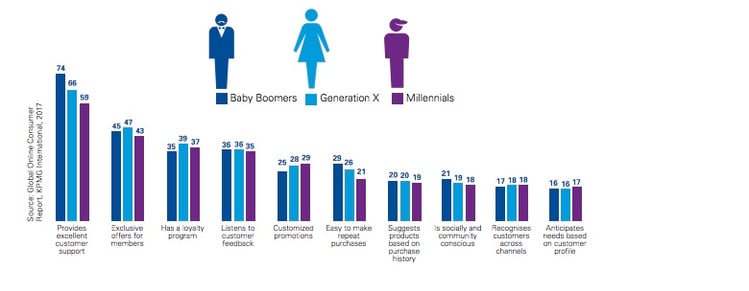Customer experience really matters in building customer loyalty.
The coveted prize today is to win customer loyalty. Loyal customers not only develop an allegiance to a company and purchase more often, they also become brand ambassadors, encouraging others to follow suit.
For example, two companies that my daughter and I have become very loyal to are @Keen and @deuterusa, pictured above on our last trip. They provide good examples of what is presented below.
Are you creating online customer loyalty?
What makes consumers loyal to one company over another? In a major study by KPMG when consumers were asked about the attributes of the companies they were most likely to be loyal to, by far the leading response (by 65 percent of respondents) was ‘provides excellent customer support’.

The top ten attributes identified in this study were:
- Provides excellent customer support
- Exclusive offers for members
- Has a loyalty program
- Listens to customer feedback
- Customized promotions
- Easy to make repeat purchases
- Suggests products based on purchase history
- Is socially and community conscious
- Recognizes customers across channels
- Anticipates needs based on customer profile
When shopping in-store, people have certain service level expectations of staff attentiveness or product knowledge. In an online environment, however, most transactions are conducted with no personal contact or service at all. So when online retailers go the extra mile by reaching out to their customers—with an unexpected personal note or an extraordinary issue resolution, for example—it gets noticed. Finding ways to provide exceptional customer support online can lead to customer loyalty in an online environment, where it can be difficult to stand out or be remembered.
Use these six pillars of customer experience to facilitate creating your own customer loyalty moat:
- Personalization
- Integrity
- Expectations
- Resolution
- Time and Effort
- Empathy
To build out these six pillars of customer experience, you need to:
- Use technology to improve the way consumers interact with you from finding information they need to solve a problem and is personalized.
- Provide a customer experience that is consistent, simple, and optimized for them.
- Streamlining the customer's purchasing experience, reducing barriers, and making it as frictionless as possible.
- Providing a brand experience across all the channels your customers engage you.
- Connecting, building, and maintaining an engaging presence with customers through social media.
- Provide your customers with a sense of belonging.
Loyalty will be granted to those companies that make their customers feel like they are part of a community, and one where they feel important, unique and valued. The bottom line is that to win and retain online customers, companies need to find cost-effective ways of providing the service and quality that customers expect, while keeping prices competitive.
HubSpot has a great resource to help you get started. The Beginner's Guide to Building Customer Loyalty.
All of your work to create loyal customers should also include creating a top-flight loyalty program to reward them.

BigCommerce has identified the following four components to an award-winning loyalty program.
Components of a Loyalty Program
All loyalty programs boil down to a simple concept – customers are rewarded for taking certain actions. Businesses customize on the above principle to create their individual loyalty programs.
These customizations consist of making changes to the following components:
1. What actions will customers be rewarded for?
Successful loyalty programs focus on a single customer action: getting customers to buy again.
However, you can also reward your customer for other types of actions such as store registrations, referrals, social shares, etc. The most successful loyalty programs focus on repeat orders and ignore ancillary actions such as social sharing, reviews, etc.
2. How will customers redeem and use their rewards?
Once your customer has earned a reward, you will need to decide how the customer will access and use their rewards. This is where most online stores make the mistake of complicating the program. Some common mistakes include:
- Making customers manually redeem points.
- Offering rewards that are difficult to use such as coupons or gift certificates.
- Avoid these mistakes by making it easy for your customers to earn, redeem and use their rewards.
3. What kinds of rewards will you offer?
You can offer your customers several kinds of rewards from free shipping to percentage off to store credit. It is tempting to assume that strong rewards will lead to a successful loyalty program.
On the contrary, an easy to use loyalty program will always outperform ones that offer greater rewards. It is best to start a loyalty program with one reward.
4. What are the rules of your customer loyalty program?
The rules of your loyalty program allow you to protect yourself from abuse. However, it’s best to have a few, sensible rules and not make it overly complicated.
Below are some simple rules to get started with:
- Rewards are available to registered customers only.
- Points earned or redeemed do not apply to tax or shipping.
- Points are earned and redeemable by the email address on account only.
- Points are non-transferable.
- Points may only be redeemed for purchases and have no cash value.
- Points are accumulated by current purchases only.
- We hold the right to cancel an account at any time.

%20(8)-1.png?length=320&name=_Blog%20Covers%20ENG%20(NAM)%20(8)-1.png)
